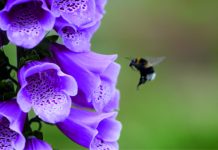February is a great month for planting trees, and we’ve got some that are a far cry from the normal! I’m going to give you some details on three that have trumpet-shaped flowers and are stunningly wow in flower – the golden trumpet tree, pink trumpet tree and golden pagoda tree. And, finally, a real toughie for those very difficult areas that most of us have!
Tabebuia is a genus containing around 100 species. The word tabebuia means ant wood in Brazilian, as ants often nest in the dead hollow branches of old trees. They are part of the Bignoniaceae family which gives you a hint of their blowsy beauty to come and they can be seen in yellow, pink, white and, rarely, red. They are commonly planted through southern and central America as street and garden trees and certainly rival the jacaranda for flowering.
Semi-evergreen, tabebuias will commonly shed their leaves for a short time in late spring, just before flowering. They are generally of a moderate growth rate and can even be grown in a pot whilst young. Eventually, in the ground, they can reach 8m high with a large spread too, so you get a big head and great impact. They like warm climates but will adapt well to poor soils and their roots are non-invasive. A windy position will slow their growth rate. On all types, the flowers are rich in nectar; pollinating insects make a bee-line for them!
Tabebuia (syn. handroanthus) ochracea, or golden trumpet tree is famed for its spectacular display of large yellow flowers. It is very closely related to tabebuia chrysotricha, which is the national tree of Brasil. The bark is rough and furrowed and the new young leaves emerge with white downy undersides. The gorgeous golden-yellow flowers last only a day but they are prolifically produced with, occasionally, a second flush too and the dangling seed pods are decorative in their own right.
Tabebuia (syn. handroanthus) impeteginosa is also known as pink lapacho, Pau D’Arco or pink trumpet tree. It is the national tree of Paraguay and is seen in huge pink clouds throughout southern Mexico, Bolivia, Peru and Argentina. It will tolerate windy coastal positions but does perform better in a cosier spot! The flowers are usually rosy-pink
with a yellow throat, though they can also have lilac tinges. The bark is well-used by native peoples for a range of treatments, most famously cancer but also for intestinal problems, fevers, dysentery, snake bites, to help with diabetes and lower blood pressure. It has strong anti-inflammatory properties and immune stimulating activity.
Sophora microphylla ‘Sun King’ commonly known as the Japanese pagoda tree, is a hybrid from Chile. More commonly seen as an arching shrub which can be wall-trained, it also makes a delightful small tree, where its flowers can dangle nicely. Unless very cold, it will be evergreen with dark green foliage, divided into 40 pairs of small, oblong leaflets, rather lacy and delicate looking. Being small leaved, it can be pruned and trained, perhaps as a fan against a wall, and makes a good bonsai plant. It’s a lovely thing and far more interesting and tropical looking than forsythia and winter jasmine, which flower at the same time, February through to April. The large luscious bell-shaped flowers are an exceptionally vivid yellow with tinges of green, waxy and exotic, with prettily protruding anthers. Although exotic looking, it tolerates exposure well and average soil. It will reach 4m x 3m spread.
Tamarix Africana ‘Springtime’ syn. t. hispanica is a great small tree for very exposed positions. It will grow in very windy sites, even exposed and coastal, where other trees would suffer. It will also tolerate a wide range of soils, from light and sandy through to heavy clay-based. Quick growing, it will reach around 6m or a little less if in very challenging conditions. It has a light and feathery canopy giving it an airy, light feeling and can be pruned and shaped as desired. In springtime it erupts into a mass of pink triangular flowers that always attract attention. If you need a windbreak, this tree is supreme.
We should have all of these in stock – and more – by the time you read this article, so come and have a chat with us.
Viveros Florena, Cómpeta, Málaga.
Tel: 689928201/Email: florenaspain@hotmail.com/viverosflorena@gmail.com
Open 10am until 4pm, closed Sundays and Mondays.
Food and Health Market every Wednesday morning.






















